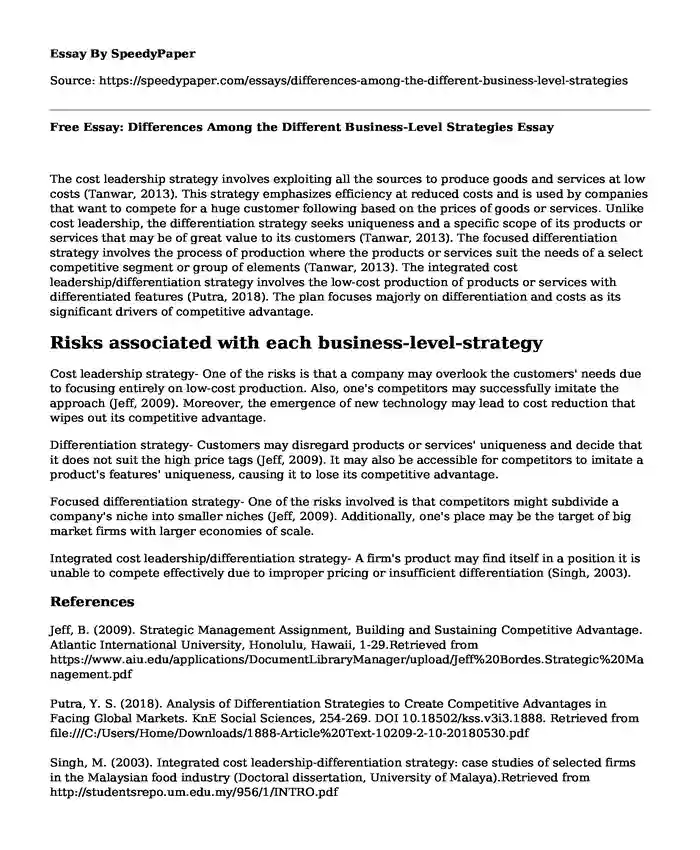
| Essay type: | Compare and contrast |
| Categories: | Business strategy Leadership style |
| Pages: | 2 |
| Wordcount: | 419 words |
The cost leadership strategy involves exploiting all the sources to produce goods and services at low costs (Tanwar, 2013). This strategy emphasizes efficiency at reduced costs and is used by companies that want to compete for a huge customer following based on the prices of goods or services. Unlike cost leadership, the differentiation strategy seeks uniqueness and a specific scope of its products or services that may be of great value to its customers (Tanwar, 2013). The focused differentiation strategy involves the process of production where the products or services suit the needs of a select competitive segment or group of elements (Tanwar, 2013). The integrated cost leadership/differentiation strategy involves the low-cost production of products or services with differentiated features (Putra, 2018). The plan focuses majorly on differentiation and costs as its significant drivers of competitive advantage.
Risks associated with each business-level-strategy
Cost leadership strategy- One of the risks is that a company may overlook the customers' needs due to focusing entirely on low-cost production. Also, one's competitors may successfully imitate the approach (Jeff, 2009). Moreover, the emergence of new technology may lead to cost reduction that wipes out its competitive advantage.
Differentiation strategy- Customers may disregard products or services' uniqueness and decide that it does not suit the high price tags (Jeff, 2009). It may also be accessible for competitors to imitate a product's features' uniqueness, causing it to lose its competitive advantage.
Focused differentiation strategy- One of the risks involved is that competitors might subdivide a company's niche into smaller niches (Jeff, 2009). Additionally, one's place may be the target of big market firms with larger economies of scale.
Integrated cost leadership/differentiation strategy- A firm's product may find itself in a position it is unable to compete effectively due to improper pricing or insufficient differentiation (Singh, 2003).
References
Jeff, B. (2009). Strategic Management Assignment, Building and Sustaining Competitive Advantage. Atlantic International University, Honolulu, Hawaii, 1-29.Retrieved from https://www.aiu.edu/applications/DocumentLibraryManager/upload/Jeff%20Bordes.Strategic%20Management.pdf
Putra, Y. S. (2018). Analysis of Differentiation Strategies to Create Competitive Advantages in Facing Global Markets. KnE Social Sciences, 254-269. DOI 10.18502/kss.v3i3.1888. Retrieved from file:///C:/Users/Home/Downloads/1888-Article%20Text-10209-2-10-20180530.pdf
Singh, M. (2003). Integrated cost leadership-differentiation strategy: case studies of selected firms in the Malaysian food industry (Doctoral dissertation, University of Malaya).Retrieved from http://studentsrepo.um.edu.my/956/1/INTRO.pdf
Tanwar, R. (2013). Porter’s generic competitive strategies. Journal of business and management, 15(1), 11-17. Retrieved from https://sswm.info/sites/default/files/reference_attachments/TANWAR%202013%20Porter%E2%80%99s%20Generic%20Competitive%20Strategies.pdf
Cite this page
Free Essay: Differences Among the Different Business-Level Strategies. (2023, Nov 28). Retrieved from https://speedypaper.net/essays/differences-among-the-different-business-level-strategies
Request Removal
If you are the original author of this essay and no longer wish to have it published on the SpeedyPaper website, please click below to request its removal:
- Essay Example on Vince Lombardi, A Legendary Coach
- Robert Mondavi Case Analysis Essay Sample
- Paper Example on Countdown Company Leadership Style
- Essay Sample: Appraising the Effects of Different Classes of Securities
- Free Essay Sample - Becoming an Exceptional Leader
- Project Management: Successful Leadership Ethics - Essay Example
- Essay Sample on Basic Concepts of Probability
Popular categories




